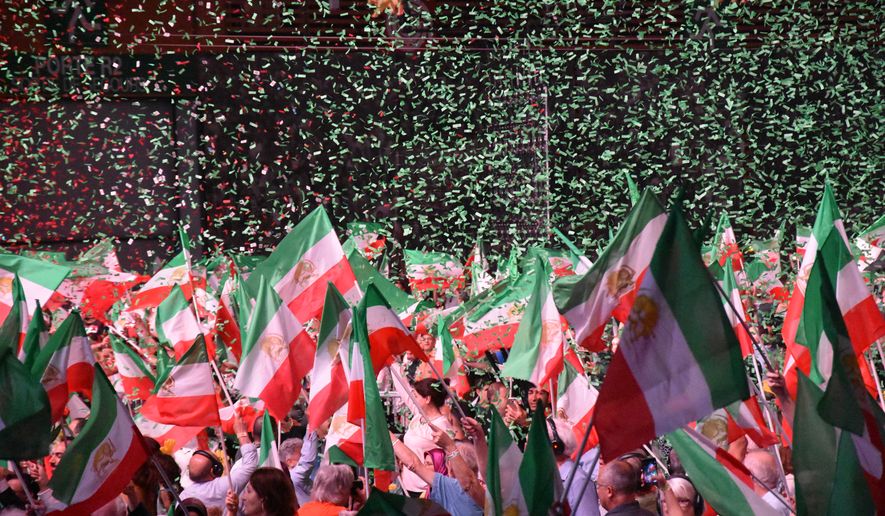PARIS — Iran’s largest dissident group is getting a fresh burst of support in its decadeslong push for regime change, as pressure builds on the Islamic regime in Tehran from the inside as well as the outside.
A large, boisterous rally here over the weekend was led by the largest opposition organization in Iran of exiles, the National Council of Resistance of Iran, a well-connected group that has found new prominence and influence in the strongly anti-Iran Trump administration.
The pressure in Iran has been mounting in the weeks since the U.S. pulled out of the 2015 nuclear deal. President Trump announced a tightening of oil and other economic sanctions, Secretary of State Mike Pompeo unveiled a string of demands to increase the pressure on Tehran, and advocates of regime change such as National Security Adviser John R. Bolton were brought into the administration’s inner circle.
Saturday’s rally also was held amid a string of large street protests in Iran over the country’s faltering economy, including traders in the conservative Grand Bazaar in Tehran incensed over a plunge in the value of the currency and persistent workers strikes.
Gunfire erupted early Sunday as Iranian security forces confronted protesters rallying against water scarcity in the country’s south. Police officers were among the 11 people reported wounded, according to The Associated Press.
Many in Paris insisted that the Iranian regime is at its weakest point in decades.
In one measure of the NCRI’s growing clout, some three dozen current and previous officials from the U.S., Europe and Middle East attended the gathering. One of the most prominent U.S. notables was Rudolph W. Giuliani, now the personal attorney for President Trump and a veteran of many NCRI events.
Mr. Giuliani made a strong call to ramp up sanctions as the protests in recent months have spread to more than 140 cities.
“When they do that, and when these protests continue to grow and grow, this threatens to topple the regime, which means freedom is right around the corner,” he said. “This is the time to put on the real pressure. The sanctions will become greater and greater.”
Red and green confetti rained on the crowd, which organizers estimated to be 100,000, right before NCRI leader Maryam Rajavi spoke.
The stage became a waving sea of red tulips in homage to the 30,000 MEK members, an NCRI faction, who were executed by the Iranian regime in 1981, still a searing memory in the MEK’s checkered and tragic history.
The floral tribute was a nod to an Iranian folk song about red tulips rising from the blood of martyrs.
Former House Speaker Newt Gingrich, a Republican, urged European nations that have balked at Mr. Trump’s tough line against Iran to get on board to tighten the economic vise.
“We need to insist that [European governments] join the sanctions once again,” Mr. Gingrich said at the rally.
The NCRI backed the ouster of the Shah of Iran with other revolutionary groups in 1979 but clashed with the Islamist forces led by Ayatollah Ruhollah Khomeini afterward. After losing a vicious power struggle, NCRI leaders now say they renounce violence.
On stage at the rally were photos of “ashrafs,” or cells of resistance in Iran. Covert activists inside Iran appeared with their faces covered because many face arrest and imprisonment from a regime that views the group as one of the prime challenges to its authority.
A question of influence
Despite its influential friends and sophisticated media outreach, analysts are divided over the relevance of the NCRI and other exile dissident groups to the political tensions inside Iran.
Mahan Abedin, a British-Iranian journalist for Middle East Eye, said he no longer tracks the group. “They are not important anymore in a strategic sense,” he said by telephone from London.
But many consider the group to be the only credible and organized opposition force outside of Iran, with extensive contacts inside the country. The NCRI has pursued its objective of regime change with discipline and laserlike focus.
Emblazoned along the stage was a giant banner, in English and Farsi for the #RegimeChangeIran, a hashtag that emerged right after Mr. Pompeo last month laid out a long list of conditions and concessions Iran would have to meet to escape future U.S. pressure.
Former Sen. Robert Torricelli, New Jersey Democrat, speaking to The Washington Times on the sidelines of the huge Paris gathering, praised the NCRI’s organizational strength and persistence.
“It’s their intensity, it’s their strength, it’s their willingness to sacrifice, and it’s the appeal of their messaging,” he said.
Ms. Rajavi inspired intense fealty from her large cohort of followers, an intensity that critics say verges on cult status. On Saturday, clad in her customary turquoise blue hijab and suit, she reiterated the NCRI’s plan for freedom and democracy in Iran, which includes separation of church and state, gender equality and freedom of expression in an Iran free of nuclear weapons.
After Ms. Rajavi spoke, the people in the crowd, wearing yellow vests to symbolize the sun in the Iranian crest, stood up to show the sign on their backs, which read, “Every moment for the uprising.”
The strong showing of dignitaries from leading Western countries included former French Foreign Minister Bernard Kouchner and Stephen Harper, a former prime minister of Canada.
Among the U.S. officials present were Bill Richardson, a former U.S. ambassador to the United Nations; former FBI Director Louis J. Freeh; and former Attorney General Michael Mukasey.
Donya Jam, a 23-year-old graduate student studying human rights and European history at George Mason University, took time off from her studies to help plan the rally.
A Christian whose parents fled Iran because of religious persecution, she has never visited Iran.
“I will not step foot in Iran until it is free,” she said.




Please read our comment policy before commenting.